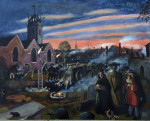
One of the points I make in my new book Where Did They Burn the Last Grand Master of the Knights Templar? A Walking Tour of Medieval Paris, is that entire cities such as Paris and London are virtual museums—all you have to do is dig.
I also discussed this in my June 6, 2015 blog post Stop the Presses: Skeletons and Not Buildings. A dig in the basement of a Paris supermarket revealed the final resting place (i.e., burial pit) of many medieval citizens (likely from a now defunct hospital located near the pit).
Moving across the Pond, Londoners have been looking forward to their new rail system that goes through Crossrail’s Liverpool Station. That is until they dug up a burial pit containing the remains of 30 plague victims. Plague pits are actually quite common across England. During the 1665 plague, it is estimated that more than 100,000 London citizens (approximately one-fifth of the city’s total population at the time) died of the plague.
Black Death Documentary
YouTube documentary on the Black Death (warning: gruesome stuff).
The Bedlam cemetery is located close to the pit and a nearby gravestone is engraved with the date of 1665. It’s thought many people were buried on the same day that year due to a single mortal event. What is interesting is that each person was buried in his or her own coffin. This is contrary to common knowledge that most corpses during the 1348 plague (or other periods of this disease) were thrown directly from the carts into the pits.
We are more familiar with the plague epidemic during the mid-14th century (1346–1353) when anywhere from 75 to 200 million people perished—likely half of Eurasia. Between 1346 and the mid-17th century, there were 17 separate periods of the plague. One historian estimates that more than 1 million French citizens died of the plague in four years of the plague during the early 17th-century. The plague of 1665 was the last major outbreak of the disease in London. Why was this? Did the Great London Fire of 1666 have anything to do with the end of the epidemic? Perhaps with further study, the skeletons unearthed in the plague pit may yield some answers to these and other questions.
London Dig Article
You can read the full article here.
Are the skeletons and remains still contaminated with the plague? According to the experts, probably not. However, did you know that Marie Curie died of radioactive poisoning and her coffin in the Panthéon is lead lined? If you want to review any of her papers, you must don a radioactive protective suit.
Do we have a lot of stories? Of course we do. I’m looking forward to sharing these with you. Please continue to visit our newsletter and blog. Perhaps you’d like to subscribe so that you don’t miss out on the most recent newsletter and blog posts.
Thanks so much for following my newsletter and blogs as well as my little journey through this incredibly interesting process of writing a series of niche walking tour books based on European historical periods or events.
Please note that I do not and will not take compensation from individuals or companies I mention or promote in my blog.
Are you following us on Facebook and Twitter?
Share This:

Copyright © 2015 Stew Ross


